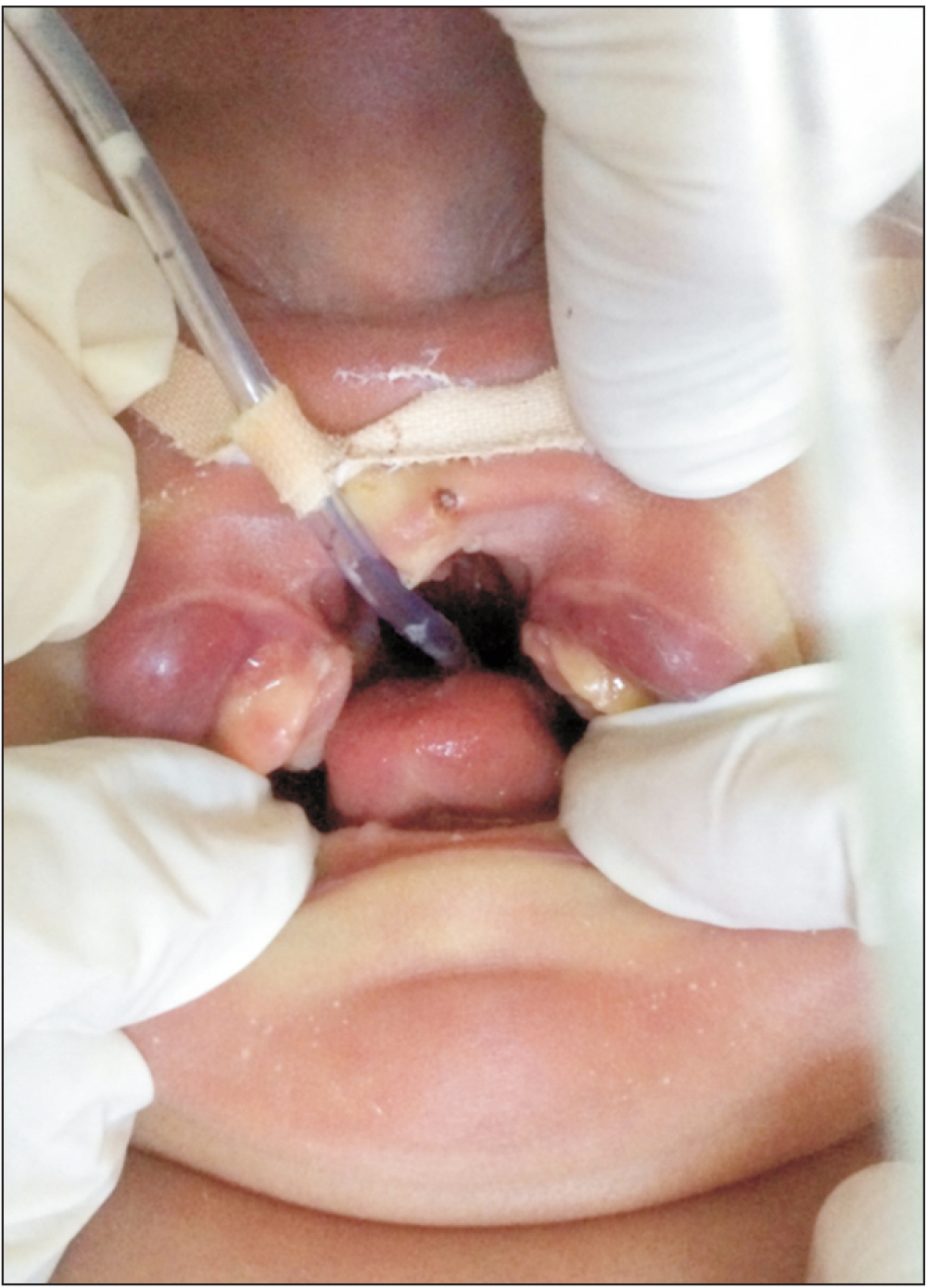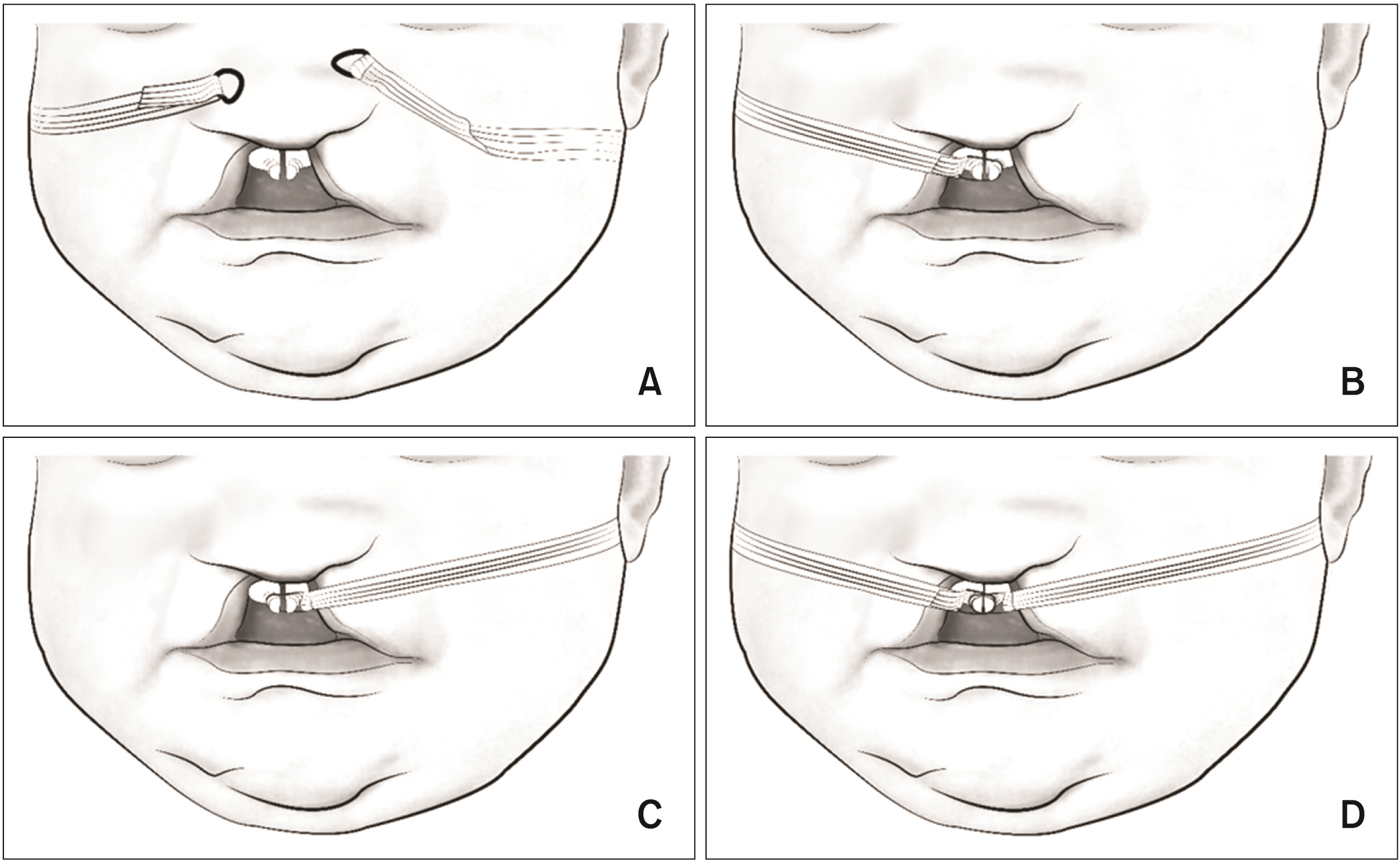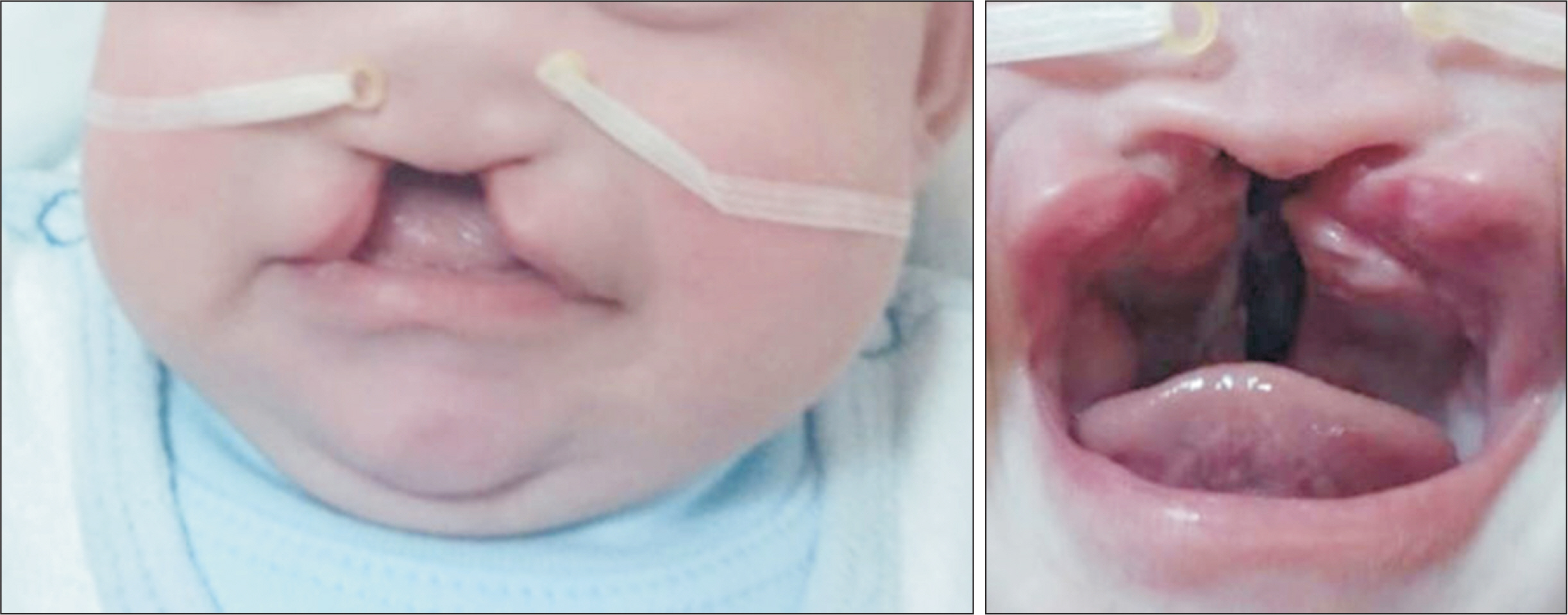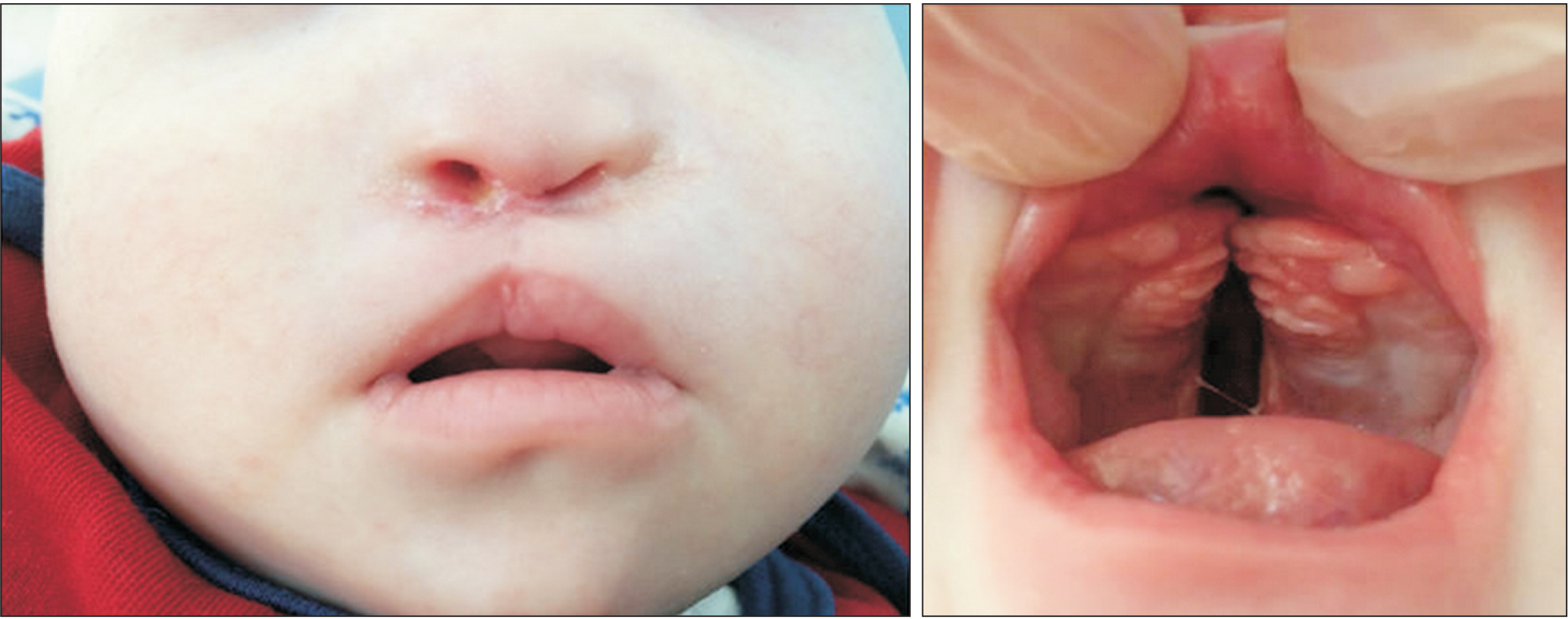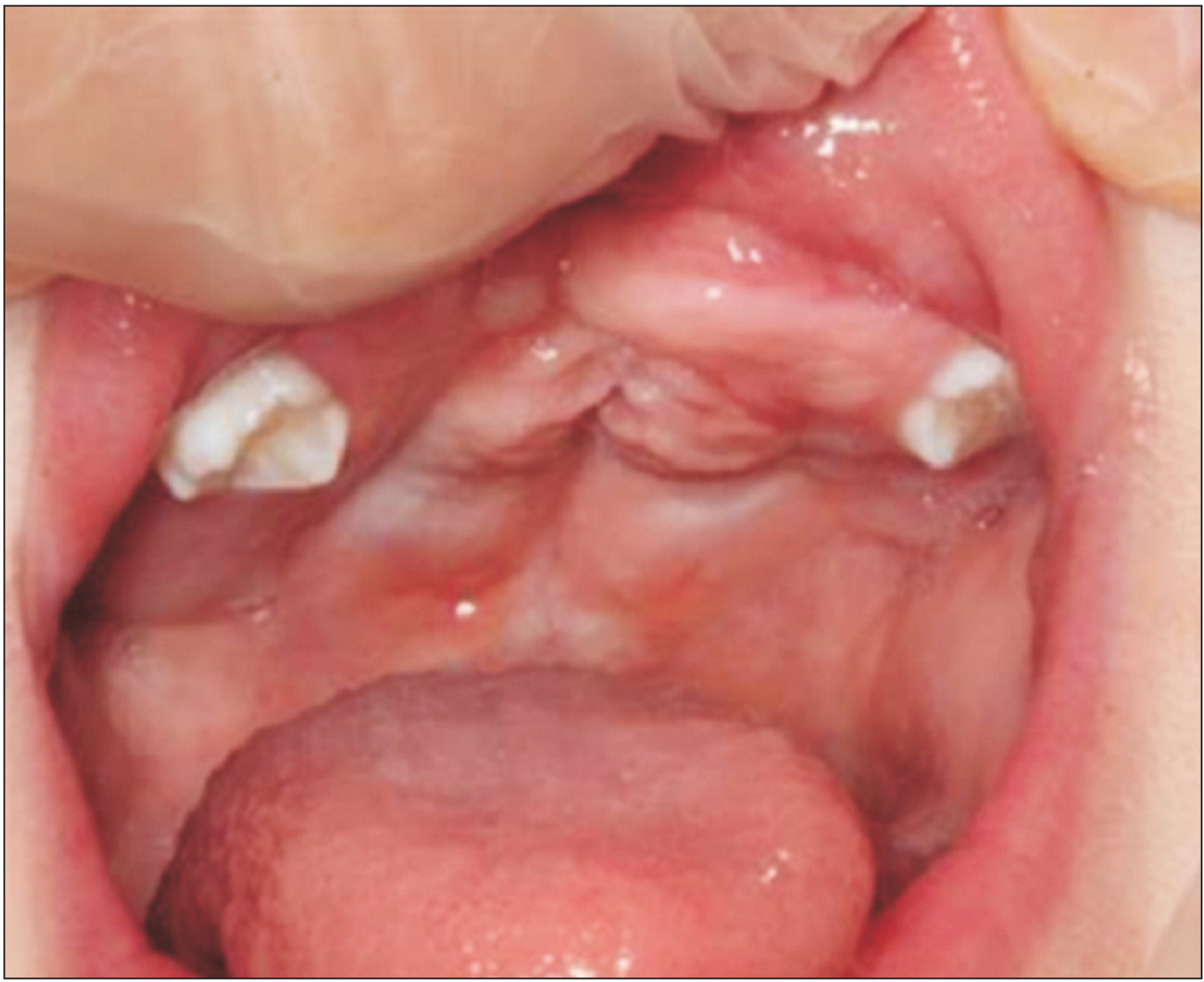Korean J Orthod.
2021 Nov;51(6):428-434. 10.4041/kjod.2021.51.6.428.
A modified presurgical alveolar molding technique for treatment of cleft in Down syndrome
- Affiliations
-
- 1Department of Orthodontics, Faculty of Dentistry, Recep Tayyip Erdoğan University, Rize, Turkey
- 2Department of Orthodontics, Faculty of Dentistry, Kocaeli University, Kocaeli, Turkey
- KMID: 2522505
- DOI: http://doi.org/10.4041/kjod.2021.51.6.428
Abstract
- Craniofacial clefts are extremely rare deformities. Tessier’s classification is a widely accepted system that is based on clinical, radiographical, and surgical observations. The Tessier No. 0 cleft most commonly affects the upper lip, nose, and palate. This case presentation aims to report the outcome of a modified presurgical alveolar molding (PAM) appliance used in the treatment of an infant with Tessier No. 0 cleft as an alternate approach to mold such defects before surgery. The modified PAM appliance consisted of reciprocal parts connected by a helix. The segments were approximated by stripping the appliance at the midline in a V-shaped manner and the force was exerted by the extraoral elastics. The procedure gave results in 8 weeks, which may be regarded as a reasonable duration. The anterior cleft gap, which was 13 mm before the treatment, was reduced to 3 mm after the treatment by using modified PAM appliance. On a 21-month follow-up period, oral reshaping was regarded successful due to stability of the improved oral mold.
Figure
Reference
-
1. Kawamoto HH. McCarthy JG, editor. 1990. Rare craniofacial clefts. Plastic surgery. W.B. Saunders;Philadelphia: p. 2952–5.2. Ozaki W, Kawamoto HK Jr. Lin K, Ogle R, Jane J, editors. 2002. Craniofacial clefting. Craniofacial surgery: science and surgical technique. W.B. Saunders;Philadelphia: p. 309–31.3. Rintala AE. 1986; Epidemiology of orofacial clefts in Finland: a review. Ann Plast Surg. 17:456–9. DOI: 10.1097/00000637-198612000-00004. PMID: 3827116.
Article4. Starck WJ, Epker BN. 1994; Surgical repair of a median cleft of the upper lip. J Oral Maxillofac Surg. 52:1217–9. DOI: 10.1016/0278-2391(94)90551-7. PMID: 7965322.
Article5. Kawamoto HK, Patel PK. Bentz M, editor. 1998. Atypical facial clefts. Pediatric plastic surgery. Appleton & Lange, cop.;Stamford: p. 175–225.6. Tessier P. 1976; Anatomical classification facial, cranio-facial and latero-facial clefts. J Maxillofac Surg. 4:69–92. DOI: 10.1016/S0301-0503(76)80013-6. PMID: 820824.7. Grayson BH, Santiago PE, Brecht LE, Cutting CB. 1999; Presurgical nasoalveolar molding in infants with cleft lip and palate. Cleft Palate Craniofac J. 36:486–98. DOI: 10.1597/1545-1569_1999_036_0486_pnmiiw_2.3.co_2. PMID: 10574667.
Article8. Grayson BH, Cutting CB. 2001; Presurgical nasoalveolar orthopedic molding in primary correction of the nose, lip, and alveolus of infants born with unilateral and bilateral clefts. Cleft Palate Craniofac J. 38:193–8. DOI: 10.1597/1545-1569_2001_038_0193_pnomip_2.0.co_2. PMID: 11386426.
Article9. Grayson BH, Maull D. 2005; Nasoalveolar molding for infants born with clefts of the lip, alveolus, and palate. Semin Plast Surg. 19:294–301. DOI: 10.1055/s-2005-925902. PMCID: PMC2884748. PMID: 15145660.
Article10. Grayson BH, Garfinkle JS. Losee JE, Kirschner RE, editors. 2009. Nasoalveolar molding and columella elongation in preparation for the primary repair of unilateral and bilateral cleft lip and palate. Comprehensive cleft care. McGraw-Hill Medical;New York: p. 701–20.11. Grayson BH, Garfinkle JS. 2014; Early cleft management: the case for nasoalveolar molding. Am J Orthod Dentofacial Orthop. 145:134–42. DOI: 10.1016/j.ajodo.2013.11.011. PMID: 24485726.
Article12. Matsuo K, Hirose T, Tomono T, Iwasawa M, Katohda S, Takahashi N, et al. 1984; Nonsurgical correction of congenital auricular deformities in the early neonate: a preliminary report. Plast Reconstr Surg. 73:38–51. DOI: 10.1097/00006534-198401000-00009. PMID: 6691074.13. McNeil CK. 1950; Orthodontic procedures in the treatment of congenital cleft palate. Dent Rec (London). 70:126–32. PMID: 24537837.14. Georgiade NG, Latham RA. 1975; Maxillary arch alignment in the bilateral cleft lip and palate infant, using pinned coaxial screw appliance. Plast Reconstr Surg. 56:52–60. DOI: 10.1097/00006534-197507000-00011. PMID: 1096192.15. Hotz M, Gnoinski W. 1976; Comprehensive care of cleft lip and palate children at Zürich university: a preliminary report. Am J Orthod. 70:481–504. DOI: 10.1016/0002-9416(76)90274-8. PMID: 1068633.
Article16. Gong X, Yu Q. 2012; Correction of maxillary deformity in infants with bilateral cleft lip and palate using computer-assisted design. Oral Surg Oral Med Oral Pathol Oral Radiol. 114(5 Suppl):S74–8. DOI: 10.1016/j.tripleo.2011.08.031. PMID: 23083960.
Article17. Doruk C, Kiliç B. 2005; Extraoral nasal molding in a newborn with unilateral cleft lip and palate: a case report. Cleft Palate Craniofac J. 42:699–702. DOI: 10.1597/04-134r.1. PMID: 16241184.
Article18. Monasterio L, Ford A, Gutiérrez C, Tastets ME, García J. 2013; Comparative study of nasoalveolar molding methods: nasal elevator plus DynaCleft® versus NAM-Grayson in patients with complete unilateral cleft lip and palate. Cleft Palate Craniofac J. 50:548–54. DOI: 10.1597/11-245. PMID: 22906392.
Article19. Bongaarts CA, van't Hof MA, Prahl-Andersen B, Dirks IV, Kuijpers-Jagtman AM. 2006; Infant orthopedics has no effect on maxillary arch dimensions in the deciduous dentition of children with complete unilateral cleft lip and palate (Dutchcleft). Cleft Palate Craniofac J. 43:665–72. DOI: 10.1597/05-129. PMID: 17105327.
Article
- Full Text Links
- Actions
-
Cited
- CITED
-
- Close
- Share
- Similar articles
-
- Presurgical naso-alveolar molding appliance for unilateral cleft lip and palate
- Effect of presurgical nasoalveolar molding (PNAM) appliance and cheiloplasty on alveolar molding of complete unilateral cleft lip and palate patients
- Biocreative Alveolar Molding Plate Treatment (BioAMP) for neonatal unilateral cleft lip and palate with excessively wide alveolar cleft and maxillary arch width
- Correction of Unilateral Cleft Lip Using Surgeon-Made Nasoalveolar Molding Device
- Analysis of alveolar molding effects in infants with bilateral cleft lip and palate when treated with pre-surgical naso-alveolar molding appliance

